#Social History
Text
More on pre-electricity lighting.
Interesting to see this one pop up again after nearly two years - courtesy of @dduane, too! :->
*****
After experiencing a couple more storm-related power cuts since my original post, as well as a couple of after-dark garden BBQs, I've come to the conclusion that C.J. Cherryh puts far too much emphasis on "how dark things were pre-electric light".
For one thing eyes adjust, dilating in dim light to gather whatever illumination is available. Okay, if there's none, there's none - but if there's some, human eyes can make use of it, some better or just faster than others. They're the ones with "good night vision".
Think, for instance, of how little you can see of your unlit bedroom just after you've turned off the lights, and how much more of it you can see if you wake up a couple of hours later.
There's also that business of feeling your way around, risking breaking your neck etc. People get used to their surroundings and, after a while, can feel their way around a familiar location even in total darkness with a fair amount of confidence.
Problems arise when Things Aren't Where They Should Be (or when New Things Arrive) and is when most trips, stumbles, hacked shins and stubbed toes happen, but usually - Lego bricks and upturned UK plugs aside - non-light domestic navigation is incident-free.
*****
Here are a couple of pics from one of those BBQs: one candle and a firepit early on, then the candle, firepit and an oil lamp much later, all much more obvious than DD's iPad screen.


Though I remain surprised at how well my phonecam was handling this low light, my own unassisted eyes were doing far better. For instance, that area between the table and the firepit wasn't such an impenetrable pool of darkness as it appears in the photo.
I see (hah!) no reason why those same Accustomed Eyes would have any more difficulty with candles or oil lamps as interior lighting, even without the mirrors or reflectors in my previous post.
With those, and with white interior walls, things would be even brighter. There's a reason why so many reconstructed period buildings in Folk Museums etc. are (authentically) whitewashed not just outside but inside as well. It was cheap, had disinfectant qualities, and was a reflective surface. Win, win and win.
*****
All right, there were no switches to turn on a light. But there was no need for what C.J. describes as stumbling about to reach the fire, because there were tinderboxes and, for many centuries before them, flint and steel. Since "firesteels" have been heraldic charges since the 1100s, the actual tool must have been in use for even longer.
Tinderboxes were fire-starter sets with flint, steel and "tinder" all packed into (surprise!) a box. The tinder was easily lit ignition material, often "charcloth", fabric baked in an airtight jar or tin which would now start to glow just from a spark.
They're mentioned in both "The Hobbit" and "The Lord of the Rings". Oddly enough, "Hobbit" mentions matches in a couple of places, but I suspect that's a carry-over from when it was just a children's story, not part of the main Legendarium.
Tinderboxes could be simple, just a basic flint-and-steel kit with some tinder for the sparks to fall on...

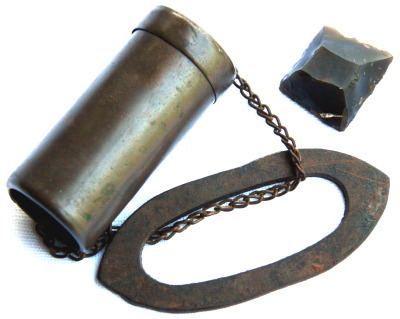


...or elaborate like this one, with a fancy striker, charcloth, kindling material and even wooden "spills" (long splinters) to transfer flame to a candle or the kindling...

This tinderbox even doubles as a candlestick, complete with a snuffer which would have been inside along with everything else.

Here's a close-up of the striker box with its inner and outer lids open:
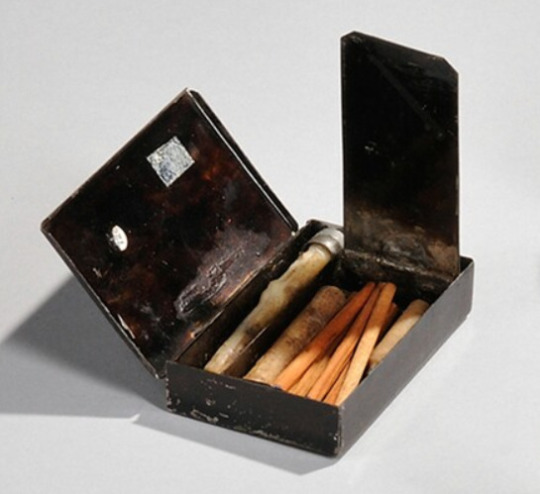
What looks like a short pencil with an eraser is actually the striker. A bit of tinder or charcloth would have been pulled through that small hole in the outer lid, which was then closed.
There was a rough steel surface on the lid, and the striker was scraped along it, like so:

This was done for a TV show or film, so the tinder was probably made more flammable with, possibly, lighter fuel. That would be thoroughly appropriate, since a Zippo or similar lighter works on exactly the same principle.
A real-life version of any tinderbox would usually just produce glowing embers needing blown on to make a flame, which is shown sometimes in movies - especially as a will-it-light-or-won't-it? tension build - but is usually a bit slow and non-visual for screen work.
*****
There were even flintlock tinderboxes which worked with the same mechanism as those on firearms. Here's a pocket version:
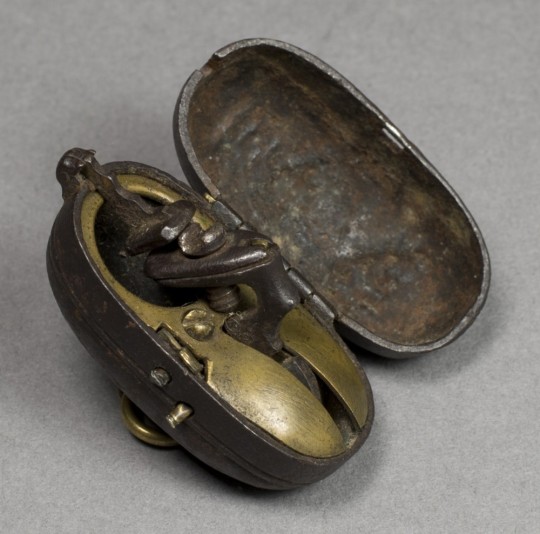
Here are a couple of bedside versions, once again complete with a candlestick:
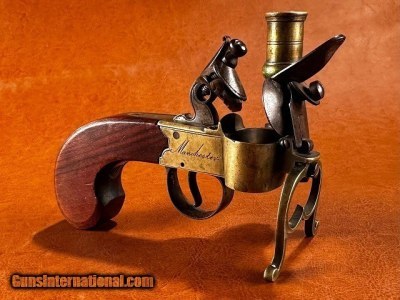
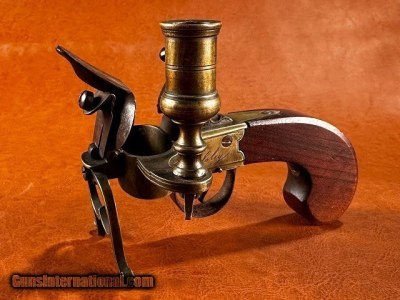
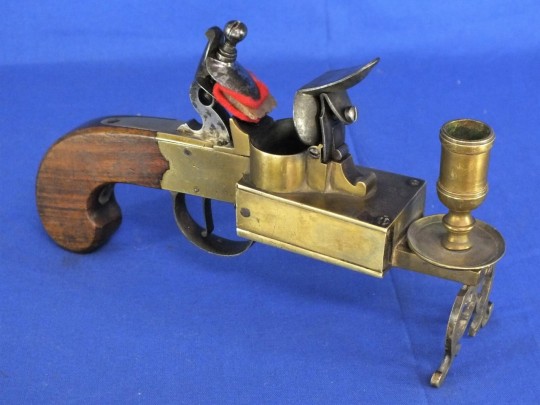
And here are three (for home defence?) with a spotlight candle lantern on one side and a double-trigger pistol on the other.


Pull one trigger to light the candle, pull the other trigger to fire the gun.
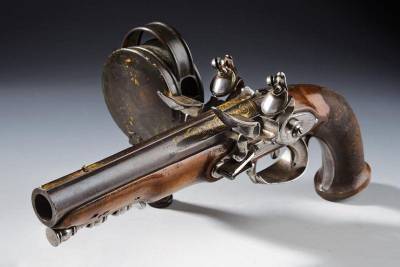

What could possibly go wrong? :-P
*****
Those pistol lanterns, magnified by lenses, weren't just to let their owner see what they were shooting at: they would also have dazzled whatever miscreant was sneaking around in the dark, irises dilated to make best use of available glimmer.
Swordsmen both good and bad knew this trick too, and various fight manuals taught how to manage a thumb-shuttered lamp encountered suddenly in a dark alley.
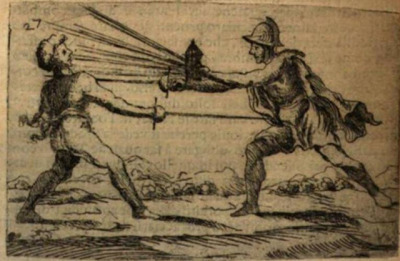
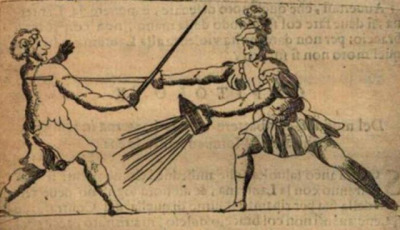
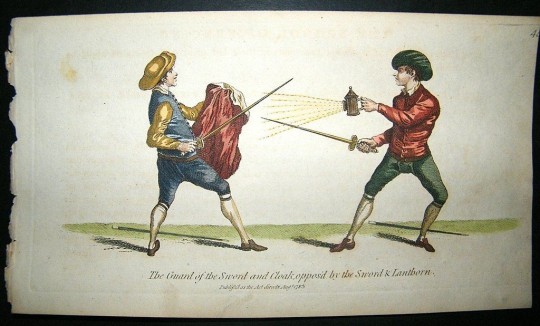
There's a sword-and-lantern combat in the 1973 "Three Musketeers" between Michael York (D'Artagnan) and Christopher Lee (Rochefort), which was a great idea.
Unfortunately it failed in execution because the "Hollywood Darkness" which let viewers see the action, wasn't dark enough to emphasise the hazards / advantages of snapping the lamps open and shut.
This TV screencap (can't get a better one, the DVD won't run in a computer drive) shows what I mean.
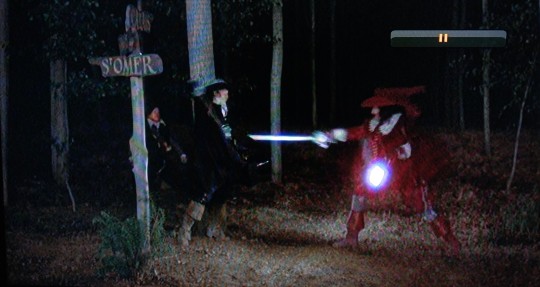
In fact, like the photos of the BBQ, this image - and entire fight - looks even brighter through "real eyes" than with the phonecam. Just as there can be too much dark in a night scene, there can also be too much light.
*****
One last thing I found when assembling pics for the post were Folding Candle-lanterns.
They were used from about the mid-1700s to the later 20th century (Swiss Army ca. 1978) as travel accessories and emergency equipment, and IMO - I've Made A Note - they'd fit right into a fantasy world whose tech level was able to make them.
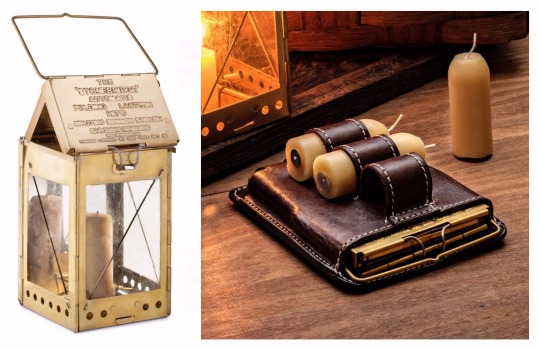
The first and last are reproductions: this one is real, from about 1830.
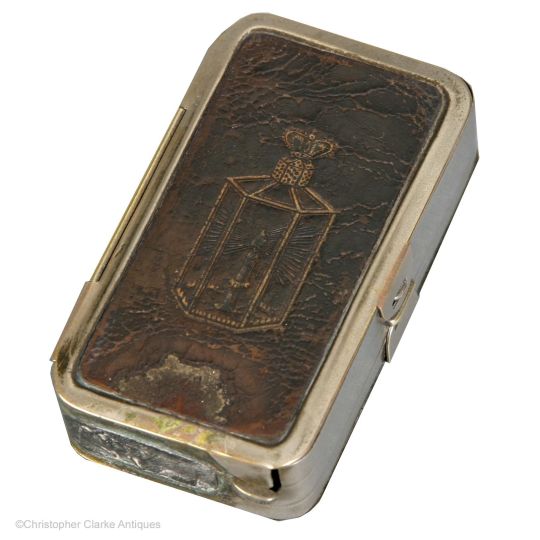
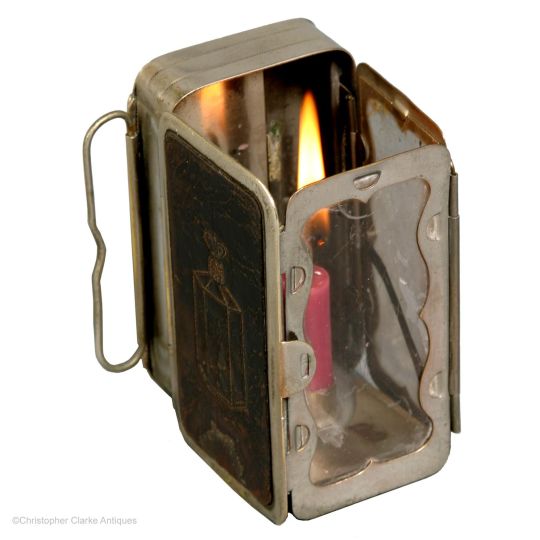
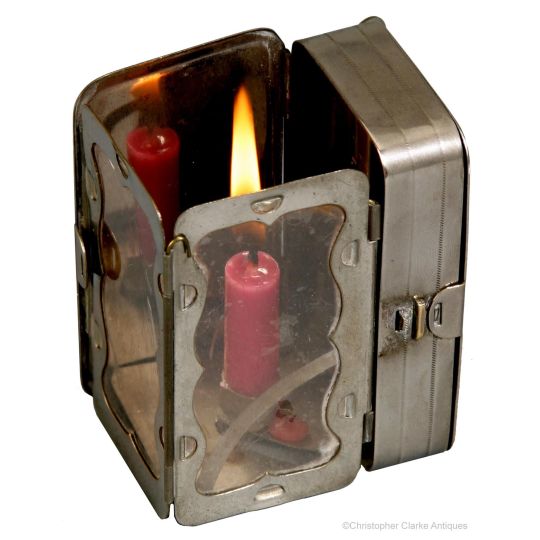
The clear part was mica - a transparent mineral which can be split into thin flexible sheets - while others use horn / parchment, though both of these are translucent rather than transparent. Regardless, all were far less likely to break than glass.
One or two inner surfaces were usually tin, giving the lantern its own built-in reflector, and tech-level-wise, tin as a shiny or decorative finish has been used since Roman times.



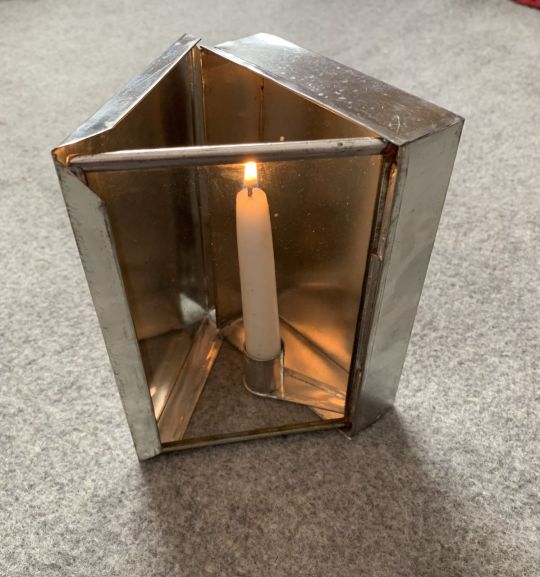
I'm pretty sure that top-of-the-line models could also have been finished with their own matching, maybe even built-in, tinderboxes.
And if real ones didn't, fictional ones certainly could. :->
*****
Yet more period lighting stuff here, including flintlock alarm clocks (!)
#period lighting#tinderbox#too light too dark#social history#writer notes#research#period tech#sword vs lantern#c. j. cherryh
1K notes
·
View notes
Text
I was just looking into the notion that widowers only had to mourn for 1 year after their wives' deaths, during the Victorian era, while widows had to mourn for two. because I've heard that a lot, but it seems to jive more with the Pop History version of the era where mourning existed because Imposing Rules On People Is Fun and All Marriages Were For Money than with the real version, inhabited by real people who idealized love matches and theoretically practiced formal mourning to show that they were going through something and needed gentle treatment
what I've gathered from a brief search for period sources seems to be:
one source from 1839 mentioned the "widows = 2 years; widowers = 1 year" thing
every other source I read (about 7, from various points in the era) implied or stated that the minimum normal period of mourning for widows and widowers was the same
That's a small sample size, but I still think it's significant
men's clothing could often be harder to visibly alter to reflect mourning, relying heavily on things like black cufflinks and collar studs that could be trickier to notice at first glance than. you know. a bonnet with a black veil over someone's face
a lot of sources talking about mourning clothes were fashion magazines aimed at women, and thus would be more likely to talk about women's mourning attire than men's
so my takeaway is that while some people at some parts of this 60-year period felt it acceptable for widowers to mourn for half the period of widows, many others at other times expected any bereaved spouse regardless of gender. obviously, in a highly misogynistic society, women's adherence to ettiquette could be much more scrutinized than men's; a widower who married six months after his wife's death would be looked askance at, but probably not subject to as much censure as a widow who did the same. and obviously, things don't go according to plan and the formal mourning system could of course backfire- forcing a woman into months of social seclusion for an abusive husband, for example
but.
the overall goal was to convey "handle with care" to the outside world. for many people, widowers were expected to need as much care as widows- and therefore to mourn for the same length of time
#victorian#victorian mourning#history#social history#a friend in my costumer circle said she wished she'd had a better way to signal her bereavement when her father died (she was 17)#because nowadays there really isn't a way to convey the same 'handle with care' message#so she really saw the utility of codified mourning signals
568 notes
·
View notes
Note
Is there any way for governments to respond to a pandemic such as Covid 19 or something worse without provoking considerable public resentment? Take no measures to prevent the spread and you’ll be blamed for the resulting public health disaster. Try to prevent the spread, and you’ll be blamed for the inevitable inequities and negative effects taken to do so, and the (mitigated, but not entirely avoided) public health disaster.
I don't mean this to come off as pessimistic or overly negative, but I would say as a matter of historic record, public health campaigns (especially anti-pandemic campaigns) tend to be quite unpopular - and my suspicion is that the mid-20th century moment where public health experts like Jonas Salk and Albert Sabin became folk heroes with enormous amounts of popular support from the middle-class parents of the Baby Boom is probably the exception that proves the rule.

You can go all the way back to the very earliest days of public health measures - the Venetian invention of the quarantine during the Black Death - to find one of the first anti public-health backlashes. Conservative Venetians felt that the free food packages that were an essential part of the quarantine process (because you don't want potentially sick people wandering the city looking for food) would make people lazy and economically dependent on the government.
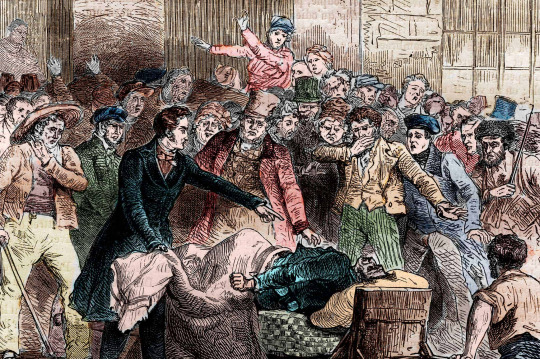
Likewise, when advances in medicine and state capacity in the early 19th century led to one of the first modern pandemic campaigns during the cholera outbreaks of the early 1830s, the public's response was not one of orderly compliance and gratefulness. Instead, you had what were called the "cholera riots" in both the U.K and Russia. Buoyed by conspiracy theories about shadowy cabals of doctors working hand in hand with an autocratic government to kill the destitute, mobs attacked symbols of public health (public hospitals, government doctors, public research clinics, anatomical colleges, health boards) and government authority (governors, police stations, quarantine cordons, court houses, etc.).
By contrast, all the anti-vaxx insanity of the past couple years seems a bit tame - at least in COVID-19, most violence has been rhetorical and abstract rather than involving the targeted murder of doctors and government officials.
Ultimately, we may just have to come to grips with the fact that public health/anti-pandemic policy is always going to be unpopular and that the correct approach is to use hard power rather than try to chivvy people into doing what's in their best interests. I certainly remember how California started to make strides against the anti-vaxx movement prior to COVID-19: it ultimately required legislation like SB 277 and SB 742 that made vaccinations more mandatory and made anti-vaxx harassment punishable with six months in jail.
155 notes
·
View notes
Text
Fathers as nurturers during the Napoleonic era

Portrait of Monsieur Gaudry giving his daughter a geography lesson, 1812, Louis-Léopold Boilly
The Gaudry portrait is even more a portrayal of “the good father” than a lesson in political geography. The painting provides evidence of a reorientation of the father’s role within the family that had taken place from the eighteenth to the nineteenth centuries. In her study of archetypal family structures during the Revolutionary period, Lynn Hunt traces “the rise and fall of the good father” and his eventual replacement, as an ambivalent figure, by republican fathers “who were now officially depicted as friendly, supportive, and interested in their children.” While the gradual transformation of the king into a good father began before the Revolution (as manifested in the portrait of Louis XVI, and not a tutor, instructing his son in geography), it was not until the Napoleonic period that a positive image of paternalism was explicitly rehabilitated, as Boilly’s commission for a portrait of the yet-childless Napoleon as père de famille so clearly indicates. In the meanwhile, children assumed new importance as the affective center of gravity in representations of families, a shift that is indicated by the painting’s focus on the demure Mlle Gaudry. Rather than reading the Gaudry portrait in twentieth-century terms, as an expression of “unusual sensitivity and psychological insight,” Boilly’s portrayal of an affectionate and respectful relationship between father and daughter is better understood as conforming to a new social construction of the family that came to the fore during the Napoleonic period, in which fathers assumed new roles as nurturers or guides.
Source: The Art of Louis-Léopold Boilly: Modern Life in Napoleonic France, Susan Siegfried, pp, 115
#Louis-Léopold Boilly#Boilly#The Art of Louis-Léopold Boilly: Modern Life in Napoleonic France#Susan Siegfried#Siegfried#napoleon#napoleonic era#napoleonic#napoleon bonaparte#first french empire#french empire#19th century#history#art#art history#history of art#social history#the geography lesson#geography#genre art#neoclassical#Neoclassicism#Monsieur Gaudry#France#french revolution#napoleonic France#French art#my pic#my pics
71 notes
·
View notes
Text

This is a memorial from Roussay on Orkney to James Leonard, an early tennant organiser. He was ultimately evicted from his land by the infamous landlord Frederick William Traill-Burroughs. Following his eviction, three of his children died of diphtheria. But his work in organising the tennants and giving evidence to the Scottish government ultimately got more protections for the crofters and may have helped prevent other clearances on Orkney.
Despite this he failed to win protection in time for the crofters of Roussay, and the island's population has gone from over 1000 at the time of the clearances to less than 100 today.
James Leonard's words still ring true today: "I am prepared to speak the truth and will not be cowed by landlordism" and "We are under the despotism and terror of the landlord and we want that removed ; even though I should fail in this battle, I will fight it out."
Today, James Leonard's farm stands derelict, and the land he rented unfarmed. Meanwhile, Burrough's grand house was gutted by a fire in the 1980s and also currently stands empty.
#uk politics#uk history#tennants#organising#highland clearances#Orkney#Scotland#social history#workers history
92 notes
·
View notes
Text
“hiSTORy iS WRitteN bY THe vicTORs¡”
Oh do fuck off with that Churchillian, pompous, small-minded, imperialist, triumphalist Great Man Theory bullshit!
That stopped being true after 1945 and you know it!
Get in the bin with that shite!
Besides I’m pretty sure that quote was actually about biased narratives.
Mind you, I’m not using it to justify revisionism or “lost cause” narratives! That shit can also get in the fucking bin! Starting yesterday.
#dougie rambles#personal stuff#vent post#history#great man theory#bullshit#historians#historiography#political crap#more or less#academics#social history#bias#biased#narratives#quotes#kind of#refutation
50 notes
·
View notes
Text
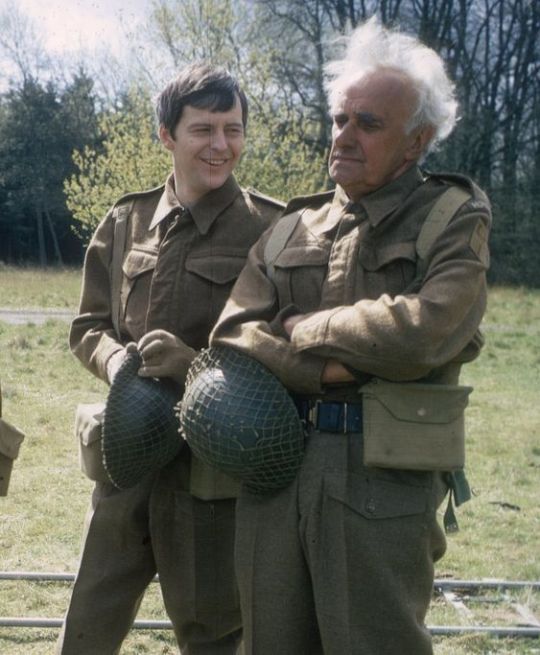
A little more on Ian Lavender, who passed away February 2nd, 2024, aged 77.
Just one of the abiding friendships between the cast of Dad’s Army was between Ian Lavender himself (born 1946) and John Laurie (born 1897).
Private Pike was Ian Lavender’s first ongoing television role, while John Laurie, a Great War veteran, had appeared in British films dating back to 1929, and was a leading Shakespearean actor on stage.
John Laurie was godfather to Ian Lavender’s children, and they were both dab hands at The Times crossword. John Laurie passed away in 1980, at the age of 83.

Ian Lavender always expressed his gratitude for having worked on Dad's Army, but admitted that typecasting had held back his career, particularly in movies, although he did appear in a handful of classic mid-seventies British films, including Carry on Behind, Not Now, Comrade, and Confessions of a Pop Performer.
He reprised his Dad's Army character, Frank Pike, in a BBC radio sequel, It Sticks Out Half a Mile, and he starred alongside Mollie Sugden in one of David Croft's rare catastrophes, the sci-fi sitcom Come Back Mrs Noah. He featured with Jimmy Edwards in The Glums, and had a series of memorable cameos on British television, including in Yes Minister, Goodnight Sweetheart, and Keeping Up Appearances.
According to his obituary in The Guardian:
"...In addition to various live Dad’s Army productions, his stage work included the Peter Hall Company’s The Merchant of Venice, with Dustin Hoffman as Shylock in 1989, touring as the Narrator in The Rocky Horror Show in 2005, Monsignor Howard in the London Palladium production of the musical Sister Act in 2009, The Shawshank Redemption at the Edinburgh fringe in 2013, and his own one-man show of reminiscences, Don’t Tell Him, Pike..."
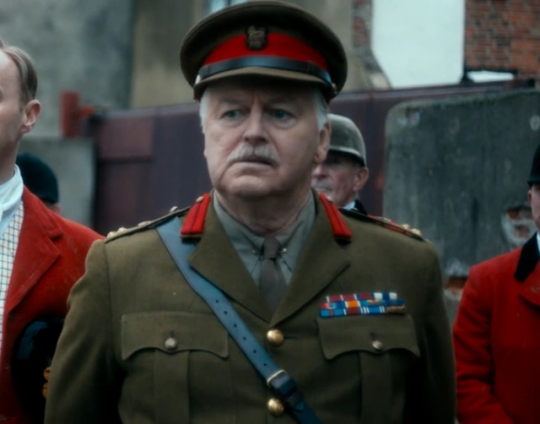
He appeared in 245 episodes of Eastenders, and was one of only two of the original Dad's Army cast members, along with Frank Williams (the Vicar), to appear in the 2016 feature film.
Here Ian Lavender recalls an unintentionally comical appearance on New Zealand radio some years after the final episode of Dad's Army.
#social history#ian lavender#dads army#british culture#british television#british theatre#british actors#classic television#yes minister#keeping up appearances#david croft#bbc radio#eastenders
24 notes
·
View notes
Text

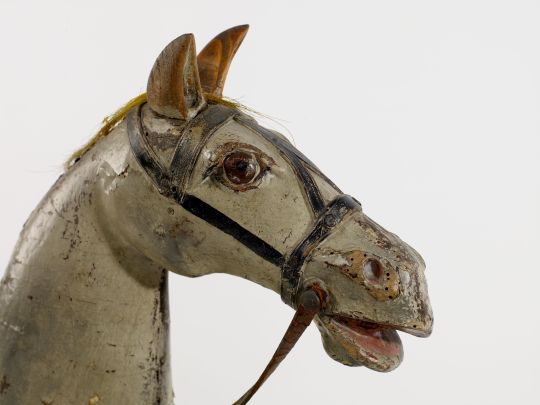


Rocking horse (1850-1900).
Creative Commons 0 - Public Domain. Photographs by Birmingham Museums Trust, licensed under CC0.
31 notes
·
View notes
Text
Today we're learning about criminals, prostitutes, secret languages and medieval heretical sects!
I want to rant about Swedish etymology, specifically regarding the word bög. It is pronounced a bit like "beg," but with the lips pursed to an O and with a long vowel (IPA: \bøːg\).
The word means "gay man" and occupies a somewhat complicated place somewhere between a slur and the established word for homosexuality. I don't really like the phonoaesthetics of the word, but then again, perhaps I just had it hurled at me one too many times in elementary school.
Anyway, etymology.
There are two main competing etymologies for this word. I'll start with the one that I think is less likely: that the word is related to English bugger and French bougre. These words have been used in various parts of Europe to mean "sodomite" for centuries, deriving from accusations leveled at the Bogomil and Cathar heresies by the Catholic Church during the medieval period. These groups were gnostics, and (according to the Church) hated the sinful physical world to the point of being antinatalists: people who believe having children is morally wrong. So far this might in theory be true, but they were also quite dubiously accused of encouraging sodomy among followers to this end. The word bugger itself is presumed to either come from Bogomil or Bulgarian, since the Balkans were the origin point of these heresies.
We know for a fact that the word was borrowed into Swedish as buger (bugern, bugrar, bugrarna) around 1900, a word used by, among others, Swedish literary titan August Strindberg. That's also where the etymology for bög becomes a bit troublesome, because bög does not appear to have been a warping of the pronunciation of this word: it is already known to have existed in the Swedish lexicon at this time.
The alternate explanation goes back to the knallar, peddlers in particularly mid-southern Sweden (Västergötland/Westrogothia) who walked door to door selling whatever they could carry with them in the countryside. These people saw their peak around the 18th and 19th centuries, before declining into obscurity at the start of the 20th. These wandering salesmen are a fascinating topic in their own right, but what's particularly important for us is their secret language, Månsing (sometimes Monsing). The Swedish language has a rich and fascinating vocabulary of words I like to call "permanent slang." These words come from thieves' cants, the secret languages of professionals (such as Månsing and Knoparmoj, the chimneysweep language), and several minority languages like Yiddish and Romani Chib. Well-known Swedish words like tjej (girl), jycke (dog) and sno (steal) are all regarded as slang in the public eye, even though the words have been in use for well over a century, if not several centuries. Since slang is usually either quickly invented and forgotten or incorporated into standard language, this is very interesting in my opinion.
One such source for "permanent slang" is Månsing. The language is extinct now, and only caught the attention of linguists when it was already in decline, but we still have a few hundred vocabulary words documented, and one of the oldest and most widespread is bögis. This word bears a striking resemblance bög, and the -is ending is a very common Swedish diminuitive, probably first introduced in Månsing where it was probably borrowed from latin, such as in the Månsing word for dog, kanis (from canis). This ending was then (perhaps humorously) added to other words, like jamis, cat (from the Swedish verb jama, to meow).
The problem is the meaning of the word. Bögis does not mean gay, sodomite, or anything of the sort, it means peasant or farmer. The related word bögishäck means farm, and so on.
The reason why this is still a plausible origin of bög has to do with the relationship these peddlers had with farm owners. The knallar were seen as anything from semi-honest traders to downright scam artists and smugglers, so what would farmers have been from their perspective? Either prospective customers or potential victims to mislead and make money off of. This use of the word bögis came to enter city slang, where it took on a new meaning among people who had different life experiences.
In the late 19th century, slang and cant dictionaries start reporting the word bögis or bög as being part of the lexicon of the lower layers of the growing city of Stockholm. The "lumpen," the thieves and prostitutes, used the word to either mean "someone who is easily fooled" or as a synonym for "mark" or "target," that is, someone you intend to either sell something to, or rob. The connection to the way the knallar used it is fairly obvious.
Over time, the word came to usually refer specifically to the customer of a prostitute, and eventually specifically one of a male prostitute, and then also the male prostitute himself, though the path there was long. In the early 20th century, bög was still competing with the previously mentioned buger, as well as with sodomit, kvinnohatare (woman-hater), homofil, homos, and several words relating to pederasty.
By the 1910s it appears that bög was winning out, and as the gay movement came to Sweden in the 70s, the word began to be reclaimed by activists, though the exact level of offense the word carries is still a bit complicated, as mentioned.
This etymology makes bög a sister word to the English word gay, which was also originally slang used in growing cities by thieves and prostitutes. It also connects it to schwul, a German word with a similar story.
This also gives us an interesting social history of the LGBT+ movement: perhaps the reason why queer rights became an issue in the 20th century is because there was no such thing as a queer subculture until the 19th century, and the reason why it emerged then is very specifically because that's the when big U Urbanizarion took place, and thus when urban crime and underground communities emerged, which have a very distinct character from their rural counterparts. In other words, maybe big cities led to the emegence of an underclass of thieves and prostitutes, and maybe we have thieves and prostitues to thank for queer rights today! That's just a speculation, though.
My main source today was the work of Fredik Silverstolpe, who has researched swedish queer history for decades. I can give you some links if you DM me, but they are all in Swedish.
#queer history#swedish#sweden#etymology#linguistics#thieves cant#secret languages#svenska#social history#history#language#mini essay#essay
64 notes
·
View notes
Text
“E” or “O”...?
A comment in the “It Was Sugar!” post wondered if "castor" with an "O" was the American spelling for caster sugar, or a typo.
It’s a typo, but one with an interesting history.
*****
“CastOr” is the spelling when referring to castor oil (pressed from castor beans) and, even older, a hat made from felted beaver fur (Castor canadiensis).
Fans of historical fiction might occasionally read that a character “doffed their castor” - meaning, raised or removed their hat in a token of good manners to ladies or respect to superiors.
"CastEr" is the spelling for a container (or its contents) for strewing, sprinkling or throwing, as in "cast aside" or “cast a shadow”.
In homophones (same-sounding words) such as sow / sew, rein / rain, peal / peel, breach / breech etc., just one letter gives the different meaning.
Words like “cast”, however, depend on context - cast a spell, cast a bell, cast a role, arm in a cast, cast in an eye, cast of the show...
English is like that.
*****
Besides sugar casters for sprinkling sugar, there were “sand casters” of wood, ceramic or metal, which contained the powder used to blot ink before or instead of blotting-paper.


This powder might be fine sand or ground sandarac resin (two reasons for “sand caster”) but also ground cuttlefish bone, or ground pumice which was called “pounce” - the French for pumice stone is “pierre ponce” - in which case the container was called a “pounce pot”.
Blotting a letter with sand or pounce may even be the origin of the phrase “done and dusted”, meaning “job all done”, though that might just derive from a room or house completely cleaned, so YMMV.
Its use is often seen in historical films, though they often get the end of the action wrong by showing writers blowing or shaking the powder off onto the floor.
In fact blotting powder was re-usable, and was poured off the paper back into the pot, whose top was often funnel-shaped to make that easier.
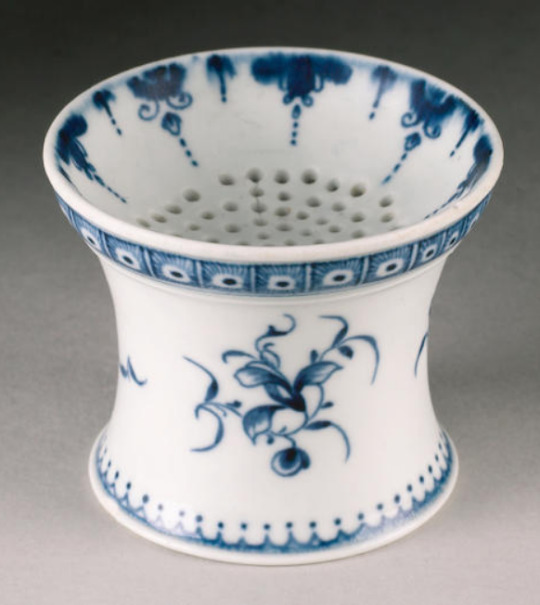
Using sand or pounce continued until fairly recently: here’s a silver writing set - inkstand with matching inkwell and pounce pot / sander - hallmarked 1908.

Fountain-pens were already in use (mass-produced since 1880) though prone to leakage until that problem was fixed in, surprise,1908, so it’s not surprising that this handsome set relied on dip pens. Also, it was probably on the desk of An Important Person who had to write little more than signatures.
The pounce pot is a curious anachronism; I’ve read one source suggesting pounce and sand continued in use because they was cheap, but penny-pinching doesn’t seem an issue here.
Maybe used blotting-paper was considered unsightly, whether as a sheet or mounted on one of those rocker-blotters still used occasionally when signing treaties.

Or maybe pounce was considered more secure; if blotting-paper picks up a good reverse impression of the writing, it can be mirror-read; there’s no way to mirror-read anything from powder.
Writer Note; a fantasy story could mention a spell which makes the pounce or sand reassemble itself as the words it blotted, so re-use is done for more than mere economy. Each time pounce is poured back into the pot it gets a thorough shaking, that world’s version of a micro-cut paper shredder or multi-pass disc wipe.
This was originally about spelling variations, so yet again I seem to have wandered a bit off-topic
I do like the silver desk-set, though.
#social history#sand caster#pounce pot#writing instruments#fun with english#homophones#same sound different spelling different meaning
130 notes
·
View notes
Text
one reason I love studying the Victorian era is that there’s just so much cultural baggage around it
every haunted house in the media is a Victorian. every ghost is a little Victorian girl in a nightgown, or a Victorian bride. if you want to call someone a prude or their attitudes backward, you call them Victorian. when people can’t think of the name for a Ye Olden Days time period, “Victorian” is one of the big ones they default to (the other being “medieval”)
who gets to be A Victorian(TM), today? our present image of the period is often very white, very cishet, very centered on men being active and women passive. when we picture oppressed groups in the Victorian era, if we do at all, they’re always miserable and focused solely on Being Downtrodden. we think of nobility waltzing in palaces and peasants grubbing in the mud or the factory, without much in between. but it was a whole 60-year time span, a general culture that existed in multiple countries: not only is that not a correct impression, it couldn’t possibly be if you sit and think about it for any length of time
“Victorian” has become a watchword for oppression, for elegance, for ignorance, for romance. it’s one of The Eras Of All Time, in our collective imagination- and that makes studying the reality of it even more fascinating to me
...also their stuff was pretty and I want it
1K notes
·
View notes
Note
OK, I'll bite - what's the deal with the United Farm Workers? What were their strengths and weaknesses compared to other labor unions?

It is not an easy thing to talk about the UFW, in part because it wasn't just a union. At the height of its influence in the 1960s and 1970s, it was also a civil rights movement that was directly inspired by the SCLC campaigns of Martin Luther King and owed its success as much to mass marches, hunger strikes, media attention, and the mass mobilization of the public in support of boycotts that stretched across the United States and as far as Europe as it did to traditional strikes and picket lines.
It was also a social movement that blended powerful strains of Catholic faith traditions with Chicano/Latino nationalism inspired by the black power movement, that reshaped the identity of millions away from asimilation into white society and towards a fierce identification with indigeneity, and challenged the racist social hierarchy of rural California.
It was also a political movement that transformed Latino voting behavior, established political coalitions with the Kennedys, Jerry Brown, and the state legislature, that pushed through legislation and ran statewide initiative campaigns, and that would eventually launch the careers of generations of Latino politicians who would rise to the very top of California politics.
However, it was also a movement that ultimately failed in its mission to remake the brutal lives of California farmworkers, which currently has only 7,000 members when it once had more than 80,000, and which today often merely trades on the memory of its celebrated founders Dolores Huerta and Cesar Chavez rather than doing any organizing work.
To explain the strengths and weaknesses of the UFW, we have to start with some organizational history, because the UFW was the result of the merger of several organizations each with their own strengths and weaknesses.
The Origins of the UFW:
To explain the strengths and weaknesses of the UFW, we have to start with some organizational history, because the UFW was the result of the merger of several organizations each with their own strengths and weaknesses.
In the 1950s, both Dolores Huerta and Cesar Chavez were community organizers working for a group called the Community Service Organization (an affiliate of Saul Alinsky's Industrial Areas Foundation) that sought to aid farmworkers living in poverty. Huerta and Chavez were trained in a novel strategy of grassroots, door-to-door organizing aimed not at getting workers to sign union cards, but to agree to host a house meeting where co-workers could gather privately to discuss their problems at work free from the surveillance of their bosses. This would prove to be very useful in organizing the fields, because unlike the traditional union model where organizers relied on the NRLB's rulings to directly access the factory floors, Central California farms were remote places where white farm owners and their white overseers would fire shotguns at brown "trespassers" (union-friendly workers, organizers, picketers).
In 1962, Chavez and Huerta quit CSO to found the National Farm Workers Association, which was really more of a worker center offering support services (chiefly, health care) to independent groups of largely Mexican farmworkers. In 1965, they received a request to provide support to workers dealing with a strike against grape growers in Delano, California.
In Delano, Chavez and Huerta met Larry Itliong of the Agricultural Workers Organizing Committee (AWOC), which was a more traditional labor union of migrant Filipino farmworkers who had begun the strike over sub-minimum wages. Itliong wanted Chavez and Huerta to organize Mexican farmworkers who had been brought in as potential strikebreakers and get them to honor the picket line.
The result of their collaboration was the formation of the United Farm Workers as a union of the AFL-CIO. The UFW would very much be marked by a combination of (and sometimes conflict between) AWOC's traditional union tactics - strikes, pickets, card drives, employer-based campaigns, and collective bargaining for union contracts - and NFWA's social movement strategy of marches, boycotts, hunger strikes, media campaigns, mobilization of liberal politicians, and legislative campaigns.
1965 to 1970: the Rise of the UFW:
While the strike starts with 2,000 Filipino workers and 1,200 Mexican families targeting Delano area growers, it quickly expanded to target more growers and bring more workers to the picket lines, eventually culminating in 10,000 workers striking against the whole of the table grape growers of California across the length and breadth of California.
Throughout 1966, the UFW faced extensive violence from the growers, from shotguns used as "warning shots" to hand-to-hand violence, to driving cars into pickets, to turning pesticide-spraying machines onto picketers. Local police responded to the violence by effectively siding with the growers, and would arrest UFW picketers for the crime of calling the police.
Chavez strongly emphasized a non-violent response to the growers' tactics - to the point of engaging in a Gandhian hunger strike against his own strikers in 1968 to quell discussions about retaliatory violence - but also began to employ a series of civil rights tactics that sought to break what had effectively become a stalemate on the picket line by side-stepping the picket lines altogether and attacking the growers on new fronts.
First, he sought the assistance of outside groups and individuals who would be sympathetic to the plight of the farmworker and could help bring media attention to the strike - UAW President Walter Reuther and Senator Robert Kennedy both visited Delano to express their solidarity, with Kennedy in particular holding hearings that shined a light on the issue of violence and police violations of the civil rights of UFW picketers.
Second, Chavez hit on the tactic of using boycotts as a way of exerting economic pressure on particular growers and leveraging the solidarity of other unions and consumers - the boycotts began when Chavez enlisted Dolores Huerta to follow a shipment of grapes from Schenley Industries (the first grower to be boycotted) to the Port of Oakland. There, Huerta reached out to the International Longshoremen's and Warehousemen's Union and persuaded them to honor the boycott and refuse to handle non-union grapes. Schenley's grapes started to rot on the docks, cutting them off from the market, and between the effects of union solidarity and growing consumer participation in the UFW's boycotts, the growers started to come under real economic pressure as their revenue dropped despite a record harvest.
Throughout the rest of the Delano grape strike, Dolores Huerta would be the main organizer of the national and internal boycotts, travelling across the country (and eventually all the way to the UK) to mobilize unions and faith groups to form boycott committees and boycott houses in major cities that in turn could educate and mobilize ordinary consumers through a campaign of leafleting and picketing at grocery stores.
Third, the UFW organized the first of its marches, a 300-mile trek from Delano to the state capital of Sacramento aimed at drawing national attention to the grape strike and attempting to enlist the state government to pass labor legislation that would give farmworkers the right to organize. Carefully organized by Cesar Chavez to draw on Mexican faith traditions, the march would be labelled a "pilgrimage," and would be timed to begin during Lent and culminate during Easter. In addition to American flags and the UFW banner, the march would be led by "pilgrims" carrying a banner of Our Lady of Guadelupe.
While this strategy was ultimately effective in its goal of influencing the broader Latino community in California to see the UFW as not just a union but a vehicle for the broader aspirations of the whole Latino community for equality and social justice, what became known in Chicano circles as La Causa, the emphasis on Mexican symbolism and Chicano identity contributed to a growing tension with the Filipino half of the UFW, who felt that they were being sidelined in a strike they had started.
Nevertheless, by the time that the UFW's pilgrimage arrived at Sacramento, news broke that they had won their first breakthrough in the strike as Schenley Industries (which had been suffering through a four-month national boycott of its products) agreed to sign the first UFW union contract, delivering a much-needed victory.
As the strike dragged on, growers were not passively standing by - in addition to doubling down on the violence by hiring strikebreakers to assault pro-UFW farmworkers, growers turned to the Teamsters Union as a way of pre-empting the UFW, either by pre-emptively signing contracts with the Teamsters or effectively backing the Teamsters in union elections.
Part of the darker legacy of the Teamsters is that, going all the back to the 1930s, they have a nasty habit of raiding other unions, and especially during their mobbed-up days would work with the bosses to sign sweetheart deals that allowed the Teamsters to siphon dues money from workers (who had not consented to be represented by the Teamsters, remember) while providing nothing in the way of wage increases or improved working conditions, usually in exchange for bribes and/or protection money from the employers. Moreover, the Teamsters had no compunction about using violence to intimidate rank-and-file workers and rival unions in order to defend their "paper locals" or win a union election. This would become even more of an issue later on, but it started up as early as 1966.
Moreover, the growers attempted to adapt to the UFW's boycott tactics by sharing labels, such that a boycotted company would sell their products under the guise of being from a different, non-boycotted company. This forced the UFW to change its boycott tactics in turn, so that instead of targeting individual growers for boycott, they now asked unions and consumers alike to boycott all table grapes from the state of California.
By 1970, however, the growing strength of the national grape boycott forced no fewer than 26 Delano grape growers to the bargaining table to sign the UFW's contracts. Practically overnight, the UFW grew from a membership of 10,000 strikers (none of whom had contracts, remember) to nearly 70,000 union members covered by collective bargaining agreements.
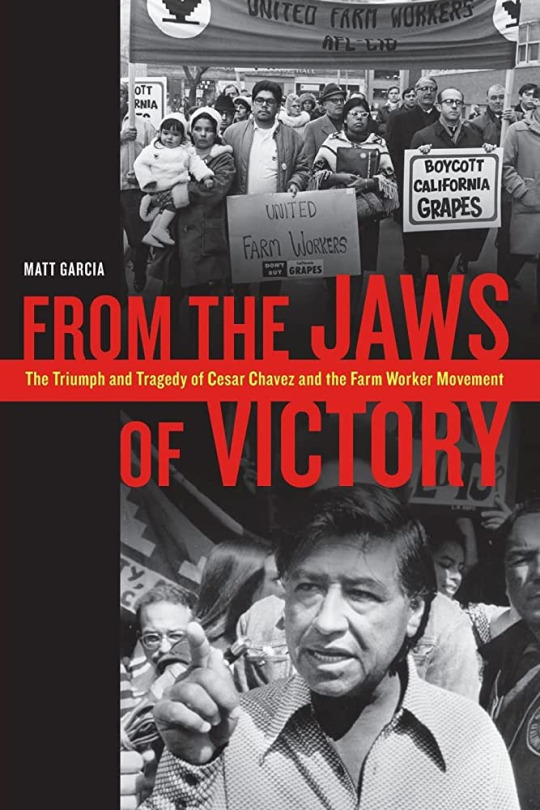
1970 to 1978: The UFW Confronts Internal and External Crises
Up until now, I've been telling the kind of simple narrative of gradual but inevitable social progress that U.S history textbooks like, the Hollywood story of an oppressed minority that wins a David and Goliath struggle against a violent, racist oligarchy through the kind of non-violent methods that make white allies feel comfortable and uplifted. (It's not an accident that the bulk of the 2014 film Cesar Chavez starring Michael Peña covers the Delano Grape Strike.)
It's also the period in which the UFW's strengths as an organization that came out of the community organizing/civil rights movement were most on display. In the eight years that followed, however, the union would start to experience a series of crises that would demonstrate some of the weaknesses of that same institutional legacy. As Matt Garcia describes in From the Jaws of Victory, in the wake of his historic victory in 1970, Cesar Chavez began to inflict a series of self-inflicted injuries on the UFW that crippled the functioning of the union, divided leadership and rank-and-file alike, and ultimately distracted from the union's external crises at a time when the UFW could not afford to be distracted.
That's not to say that this period was one of unbroken decline - as we'll discuss, the UFW would win many victories in this period - but the union's forward momentum was halted and it would spend much of the 1970s trying to get back to where it was at the very start of the decade.
To begin with, we should discuss the internal contradictions of the UFW: one of the major features of the UFW's new contracts was that they replaced the shape-up with the hiring hall. This gave the union an enormous amount of power in terms of hiring, firing and management of employees, but the quid-pro-quo of this system is that it puts a significant administrative burden on the union. Not only do you have to have to set up policies that fairly decide who gets work and when, but you then have to even-handedly enforce those policies on a day-to-day basis in often fraught circumstances - and all of this is skilled white-collar labor.
This ran into a major bone of contention within the movement. When the locus of the grape strike had shifted from the fields to the urban boycotts, this had made a new constituency within the union - white college-educated hippies who could do statistical research, operate boycott houses, and handle media campaigns. These hippies had done yeoman's work for the union and wanted to keep on doing that work, but they also needed to earn enough money to pay the rent and look after their growing families, and in general shift from being temporary volunteers to being professional union staffers.
This ran head-long into a buzzsaw of racial and cultural tension. Similar to the conflicts over the role of white volunteers in CORE/SNCC during the Civil Rights Movement, there were a lot of UFW leaders and members who had come out of the grassroots efforts in the field who felt that the white college kids were making a play for control over the UFW. This was especially driven by Cesar Chavez' religiously-inflected ideas of Catholic sacrifice and self-denial, embodied politically as the idea that a salary of $5 a week (roughly $30 a week in today's money) was a sign of the purity of one's "missionary work." This worked itself out in a series of internicene purges whereby vital college-educated staff were fired for various crimes of ideological disunity.
This all would have been survivable if Chavez had shown any interest in actually making the union and its hiring halls work. However, almost from the moment of victory in 1970, Chavez showed almost no interest in running the union as a union - instead, he thought that the most important thing was relocating the UFW's headquarters to a commune in La Paz, or creating the Poor People's Union as a way to organize poor whites in the San Joaquin Valley, or leaving the union altogether to become a Catholic priest, or joining up with the Synanon cult to run criticism sessions in La Paz. In the mean-time, a lot of the UFW's victories were withering on the vine as workers in the fields got fed up with hiring halls that couldn't do their basic job of making sure they got sufficient work at the right wages.

Externally, all of this was happening during the second major round of labor conflicts out in the fields. As before, the UFW faced serious conflicts with the Teamsters, first in the so-called "Salad Bowl Strike" that lasted from 1970-1971 and was at the time the largest and most violent agricultural strike in U.S history - only then to be eclipsed in 1973 with the second grape strike. Just as with the Salinas strike, the grape growers in 1973 shifted to a strategy of signing sweetheart deals with the Teamsters - and using Teamster muscle to fight off the UFW's new grape strike and boycott. UFW pickets were shot at and killed in drive-byes by Teamster trucks, who then escalated into firebombing pickets and UFW buildings alike.
After a year of violence, reduced support from the rank-and-file, and declining resources, Chavez and the UFW felt that their backs were up against a wall - and had to adjust their tactics accordingly. With the election of Jerry Brown as governor in 1974, the UFW pivoted to a strategy of pressuring the state government to enact a California Agricultural Labor Relations Act that would give agricultural workers the right to organize, and with that all the labor protections normally enjoyed by industrial workers under the Federal National Labor Relations Act - at the cost of giving up the freedom to boycott and conduct secondary strikes which they had had as outsiders to the system.

This led to the semi-miraculous Modesto March, itself a repeat of the Delano-to-Sacramento march from the 1960s. Starting as just a couple hundred marchers in San Francisco, the March swelled to as many as 15,000-strong by the time that it reached its objective at Modesto. This caused a sudden sea-change in the grape strike, bringing the growers and the Teamsters back to the table, and getting Jerry Brown and the state legislature to back passage of California Agricultural Labor Relations Act.
This proved to be the high-water mark for the UFW, which swelled to a peak of 80,000 members. The problem was that the old problems within the UFW did not go away - victory in 1975 didn't stop Chavez and his Chicano constituency feuding with more distinctively Mexican groups within the movement over undocumented immigration, nor feuding with Filipino constituencies over a meeting with Ferdinand Marcos, and nor escalating these internal conflicts into a series of leadership purges.
Conclusion: Decline and Fall
At the same time, the new alliance with the Agricultural Labor Relations Board proved to be a difficult one for the UFW. While establishment of the agency proved to be a major boon for the UFW, which won most of the free elections under CALRA (all the while continuing to neglect the critical hiring hall issue), the state legislature badly underfunded ALRB, forcing the agency to temporarily shut down. The UFW responded by sponsoring Prop 14 in the 1976 elections to try to empower ALRB, and then got very badly beaten in that election cycle - and then, when Republican George Deukmejian was elected in 1983, the ALRB was largely defunded and unable to achieve its original elective goals.
In the wake of Deukmejian, the UFW went into terminal decline. Most of its best organizers had left or been purged in internal struggles, their contracts failed to succeed over the long run due to the hiring hall problem, and the union basically stopped organizing new members after 1986.
#history#u.s history#labor history#ufw#united farm workers#cesar chavez#dolores huerta#trade unions#social history#social movements#unions
52 notes
·
View notes
Text
Napoleon and Water
Excerpt from the book Aaron Burr in Exile: A Pariah in Paris, 1810-1811, by Jane Merrill and John Endicott
Aaron Burr lived in Paris for 15 months, and this book goes into detail about those years living under Napoleon’s rule. This part focuses on Napoleon’s water related reforms.
———
Napoleon’s fountains gave drinking water to the population, that is, children drank water, not beer. The water was free, not purchased. And the apartment would have had a separate water closet equipped with squat toilets (adopted from the Turks) and a bucket to wash it after use. Some restaurants and cafes had W.C.s, even one for ladies and one for gents. These were hooked into the sewer system that branched under each important street.
Napoleon merits points for delivering fresh water to Paris. If serving Paris with water from the d'Ourcq River by canals was not be a consummate success, Paris gained 40 new fountains, and the emperor commanded that fountains run all day (instead of a few limited hours) and that the water be free of charge.
Perhaps the most laudable of Napoleon’s policies were utilitarian city works, especially bringing clean water and sanitation to Paris. The improvements to infrastructure included new quays to prevent floods, new gutters and pavement, new aqueducts and fountains, and relocating cemeteries and slaughterhouses to the outskirts of the city. This was also a way of keeping up employment. An Austrian aristocrat in town during Napoleon’s wedding to Marie-Louise wrote his mother, in Vienna: “Nothing can give an idea of the immense projects undertaken simultaneously in Paris. The incoherence of it is incredible; one cannot imagine that the life of a single man would be enough to finish them.”
It was a tall order. Previous rulers had been aware of the problems and one big engineering initiative, a failed marvel, had been the waterworks at Marly, located on the banks of the Seine about seven miles from Paris. Louis XIV had it constructed to pump water from the river to his chateaux of Versailles and Marly. This was the machine marvel of its age, with 250 pumps that forced river water up a 500-foot rise to an aqueduct, and it was a sight Burr mentions going to see. By 1817 the “Marly machine” had deteriorated because it was made of wood, and the waterworks were abandoned.
Charles-Augustin Sainte-Beuve, the prominent 19th century literary critic, wrote that there had been “ten years of anarchy, sedition and laxity, during which no useful work had been undertaken, not a street had been cleaned, not a residence repaired nothing improved or cleansed.” Postrevolutionary Paris was at a nadir in terms of both the inadequate, disease-ridden water supply and the filthy streets, which were basically open sewers, deep with black mud and refuse.
“Napoleon,” writes Alistair Horne, “was obsessed by the water of Paris, and everything to do with it.”
Parisians had mostly been getting their water directly from the Seine or lining up at the scant pay fountains. In 1806, nineteen new wells for fountains were dug that flowed day and night and were free. Napoleon had a canal built 60 miles from the River Ourcq, ordering 500 men to dig it, while still a consul in 1801. It brought water to the Bassin de la Villette, opening in 1808. Some doubted the wisdom of having such an abundance of water—an oriental luxury that might incur moral decay. Now the supply of water for firefighting was also much improved. The canal had light boats, as Napoleon tried to make back some of the huge expenditure by licensing navigation, and a circular aqueduct from which underground conduits went to the central city. In 1810, there were still many water porters wheeling barrels through the city.
Now Napoleon attacked the problem of the Seine as a catchall for pollution. Parisians were so used to it that men swam naked in the river and a contemporary guidebook advised merely that the water of the Seine had no ill effects on foreigners so long as they drank it mixed with wine or a drop of vinegar. Thus houses on bridges were demolished and an immense push began to clean and modernize the city sewers.
As this book is about Aaron Burr, here is section about Burr taking inspiration by a new water related invention during his time in Paris:
Remarkably for someone who was very aware of his health, he never complained of the water. He did, however, take an interest in an invention to make it easier to dig a well. When the inventor of a process to make vinegar from the sap of any tree was not in his shop, Burr and a friend, “Crede”, went to see another invention: “We went then to see Mons. Cagniard, and his new invention of raising water and performing any mechanical operation. His apparatus is a screw of Archimedes turned the reverse, air, water, and quick silver. Cagniard was abroad; but we saw a model, and worked it, and got the report of a committee of the Institute on the subject. If the thing performs what is said I will apply it to give water to Charleston.”
[Bold italics for quotations by me]
#Aaron Burr in Exile: A Pariah in Paris 1810-1811#Aaron Burr#Jane Merrill#John Endicott#napoleon#napoleonic era#napoleonic#napoleon bonaparte#first french empire#french empire#19th century#france#history#Paris#french history#water#water history#Napoleon’s reforms#social reforms#social history
99 notes
·
View notes
Text

Thomas Hart Benton
Jesse James, from the Missouri State Capitol Mural Series, 1936 - Lithograph on Rives paper with GCM watermark, signed in pencil, from the edition of 100. - 16 1/4 x 21 7/8in
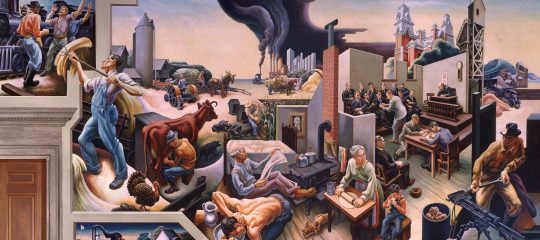
Thomas Hart Benton’s "A Social History of the State of Missouri". The mural, which is located in the House Lounge, has been open for public viewing since its completion in 1936.

Thomas Hart Benton with his painting Persephone via Kansas City Public Library

Thomas Hart Benton - Persephone
Thomas Hart Benton: 10 Facts About the American Painter
Thomas Hart Benton Was Born In A Small Missouri Town
Benton Attended The Art Institute Of Chicago And Académie Julien In Paris
He Was An Illustrator For The U.S. Navy During WWI - (Photograph Below)
He Was Jackson Pollock’s Teacher
He Was Head Of Kansas City Art Institute’s Painting Department
He Had Some Interesting Run-Ins With Magazines - (Explanation Below)
Benton’s Mural With Ku Klux Klan Members Still Sparks Controversy (Mural & Controversial Panel Below)
He Created A Mural For Missouri’s Capitol Building (Above the Fold)
Benton Was An Avid Harmonica Player
You Can Visit Thomas Hart Benson’s Home In Kansas City
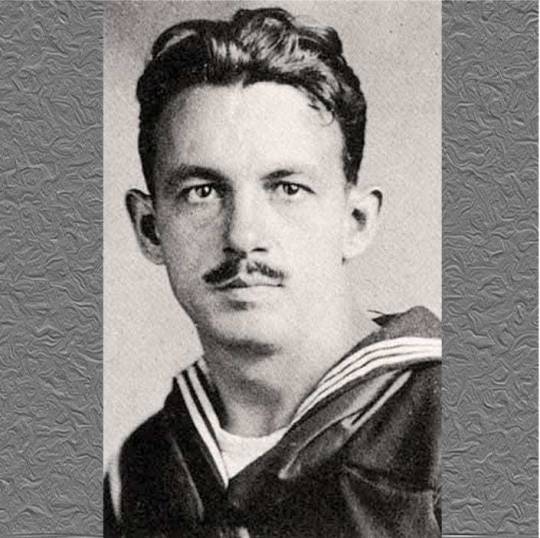
Thomas Hart Benton Service Photo

In 1934, Thomas Hart Benton was the first artist to ever appear on the cover of TIME Magazine.

Thomas Hart Benton - "Hollywood" - 1938
In 1937, Life Magazine commissioned a large painting from Benton on the subject of Hollywood, even paying for him to take a trip there over the summer of that year. His famous painting, Hollywood, was completed in 1938. When Life Magazine first saw the work, they immediately disapproved and wanted nothing to do with it, but the popularity of the work changed their tune and they included it in their spread about Hollywood.

A Social History of Indiana by Thomas Hart Benton, 1933, via The University of Indiana Bloomington
Thomas Hart Benton was commissioned to create a large mural for the state of Indiana in 1932 and it was presented at the 1933 Chicago World’s Fair. The mural, A Social History of Indiana, is made up of 22 large panels, spanning 250 ft in total, representing the state of Indiana.
The inclusion of the Ku Klux Klan brought heavy criticism when the mural was exhibited at the World’s Fair, but this didn’t stop the mural from being one of the most popular exhibits.
Cultural Panel 10 ("Parks, the Circus, the Klan, the Press") depicts a vivid, startling image of a Ku Klux Klan rally and a burning cross. The Klan had ruled Indiana politics during the 1920s—much to the embarrassment of progressives like Col. Lieber who preferred to bury the state's sins of the past.
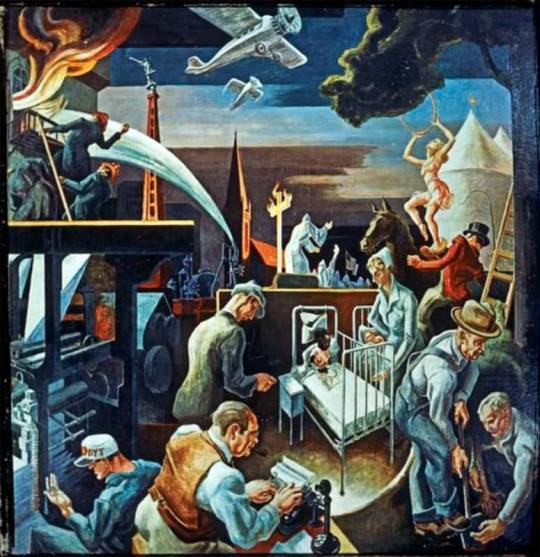
Cultural Panel #10 - The controversial panel, it is sad to see many of todays younger generation missing the point and simply looking to be offended by the past. (In 2017, students passed around a petition calling for its removal to which the university declared the lecture hall where it hangs will no longer be used for classes).

In Thomas Hart Benton’s Indiana mural, he attempts to point out the full history of Indiana, the good and the bad. Benton was not celebrating the Klu Klux Klan (KKK) in the mural, yet reminding the people of Indiana to recognize the past evils and how they were overcome.

Born: April 15, 1889 in Neosho, Missouri, son of Maecenus Eason Benton and Elizabeth Wise Benton
Died: January 19, 1975 in Kansas City, Missouri while finishing a large mural for the Country Music Hall of Fame in Nashville, Tennessee
#art#lithograph#Thomas Hart Benton#paintings#drawings#murals#artists#hollywood#time magazine#life magazine#social history#persephone#indiana#missouri#ku klux klan#jackson pollock#world's fair
40 notes
·
View notes
Text
If you're interested in Heroic Age exploration, or history, or historical fiction with male characters, you will probably find this short series interesting and helpful – I certainly did! It does an amazing job of encapsulating a lot of complex ideas and social history in an entertaining and easily digestible form.
29 notes
·
View notes
Text
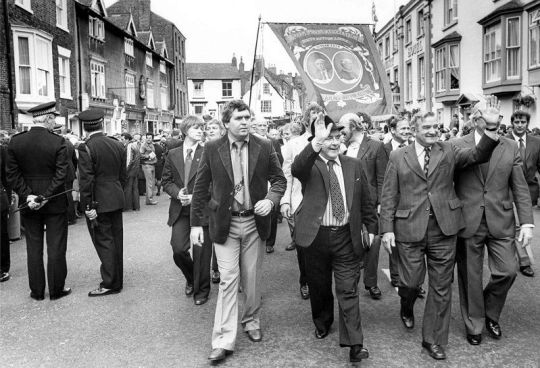

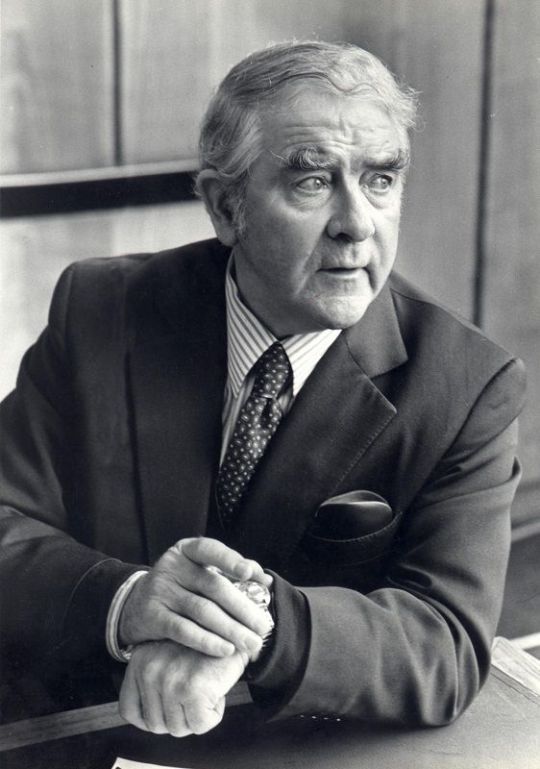
On February 18th, 1981, a BBC headline announced something that would be unthinkable three years later, 'Thatcher Gives in to Miners'.
"…Mrs Thatcher's Conservative Government has withdrawn plans to close 23 pits in its first major u-turn since coming to power two years ago. President of the National Union of Mineworkers Joe Gormley is confident the government's intervention will avert the threatened national miners' strikes…"
After crisis talks in Whitehall between union leaders and Energy Secretary, David Howell, the government agreed to reduce coal imports from eight million to 5.5 million tons and to reinstate higher operating subsidies.
NUM President Joe Gormley stated that as a result of commitments given, he would not be recommending a strike despite overwhelming support for industrial action from within the union membership.
Not everyone was happy;
"…The next day the NUM told all miners to return to work after the executive voted to accept the concessions made by the government and coal board by 15 to 8, with one abstention. Some left-wing pits maintained unofficial stoppages and there were pickets outside the NUM headquarters in London…"
When the government confirmed an injection of 300 million pounds in industry support, the unofficial action was called off and rebel pits were operating again by 20th February. Just over a year later, Joe Gormley secured a 9.3 % pay rise for miners, and was replaced by Arthur Scargill as NUM President.
In a 2002 BBC documentary, a former Special Branch officer claimed that Joe Gormley was a security services informant during the 1970s, having become concerned over the increasing influence within the NUM of left-wing militants.
Arthur Scargill opined,
"…The history of our movement is littered with people in leadership positions who were either connected with Special Branch or connected with the State..."
Joe Gormley was awarded a Life Peerage in 1982, and passed away in 1993.
#social history#uk politics#working class history#social justice#modern history#uk government#british culture#society#uk history#coal mining#coal industry#industrial action#trade unions
25 notes
·
View notes